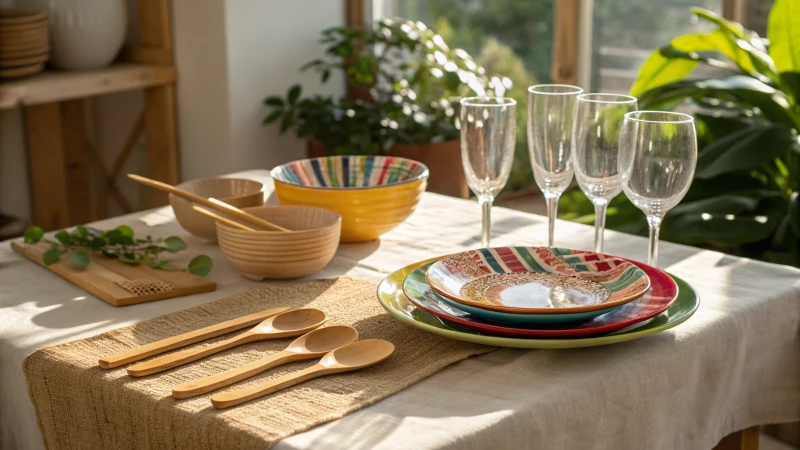
Remember the last time you grabbed a wooden fork at a picnic? It might be doing more than just holding your potato salad!
Choosing eco-friendly disposable wooden cutlery helps reduce plastic waste, supports biodegradability, and relies on renewable resources, making it a sustainable option for both businesses and consumers.
I vividly recall my first dive into eco-conscious choices. It was during a family gathering where the usual plastic utensils were replaced with smooth, wooden ones. Not only did they add a rustic charm, but they also sparked conversations about sustainability among us. It was a small change, but it felt like a step towards a larger movement of environmental responsibility.
Exploring why wooden cutlery is gaining popularity opens up a world of understanding beyond just its environmental impact. It's about aligning our everyday choices with a sustainable future, influencing market trends, and paving the way for eco-friendly dining solutions. Whether you're like me, trying to make small changes at home, or managing a business keen on sustainability, embracing wooden cutlery is a step in the right direction.
Wooden cutlery reduces plastic waste significantly.True
Wooden cutlery is biodegradable, unlike plastic, reducing waste.
Wooden cutlery is not sourced from renewable resources.False
Most wooden cutlery is sourced from renewable resources.
Why Choose Wooden Cutlery Over Plastic?
Imagine hosting a dinner party where your cutlery choices speak volumes about your commitment to the planet.
Wooden cutlery is often favored over plastic because it breaks down naturally and is sourced from renewable materials. Unlike plastic, which can linger in the environment for hundreds of years, wooden utensils decompose quickly, offering a more eco-friendly solution for disposable cutlery needs.
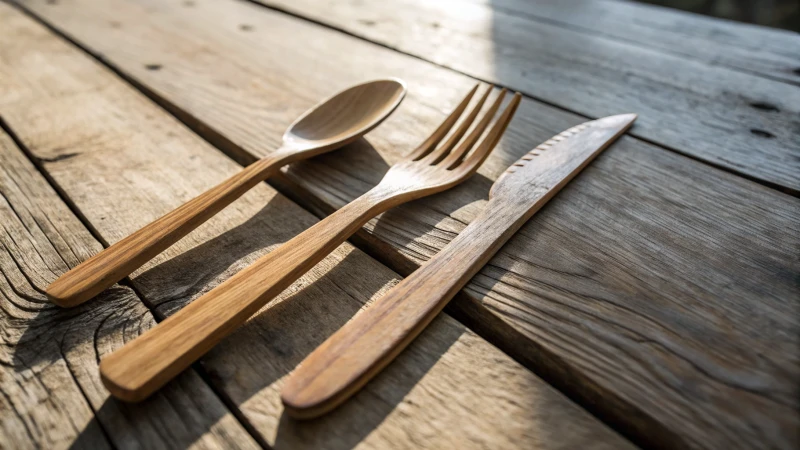
Environmental Impact
I remember the first time I realized just how much waste plastic creates. It was during a beach cleanup when I found countless plastic forks and knives washed ashore. That's when I decided to make a change. Wooden cutlery, made from renewable resources like birch or bamboo, is biodegradable and compostable. It doesn’t contribute to marine pollution1 and reduces landfill waste significantly.
Cost Considerations
Initially, I was skeptical about the cost of switching to wooden cutlery. But over time, I noticed potential savings as waste management fees decreased. Plus, as more people began opting for wooden over plastic, prices started leveling out. The upfront investment became worthwhile as the environmental benefits and potential cost savings became clear.
| Type | Biodegradable | Renewable | Cost |
|---|---|---|---|
| Wooden | Yes | Yes | Higher |
| Plastic | No | No | Lower |
Usability and Aesthetics
There's something rustic and charming about wooden cutlery that you just don't get with plastic. When I hosted an eco-friendly event, the guests appreciated the tactile quality and natural look of the wooden utensils. They’re perfect for events that aim to enhance a green image2, even though plastic might still have an edge when it comes to cutting through tougher foods.
Health and Safety
I’ve always been cautious about what comes into contact with my food. Wooden utensils are free from harmful chemicals that might leach from plastics when exposed to hot foods. This makes them a safer choice for those of us who are health-conscious and concerned about the health impacts3 of everyday items.
Customization Opportunities
One of my favorite aspects of wooden cutlery is the customization potential. Whether it's branding or unique designs, wooden utensils offer businesses a way to promote their brand while committing to sustainable practices. This opportunity allows businesses to create a unique dining experience that resonates with their identity.
Wooden cutlery is biodegradable and compostable.True
Wooden cutlery, made from renewable resources, breaks down naturally.
Plastic cutlery is more expensive than wooden cutlery.False
Plastic cutlery is generally cheaper due to lower material costs.
Why Choose Wooden Cutlery for the Environment?
Imagine dining with utensils that not only serve your meal but also serve the planet.
Wooden cutlery is eco-friendly because it's biodegradable, requires less energy to produce than plastic, and is made from renewable resources. These factors reduce environmental impact and promote sustainability.
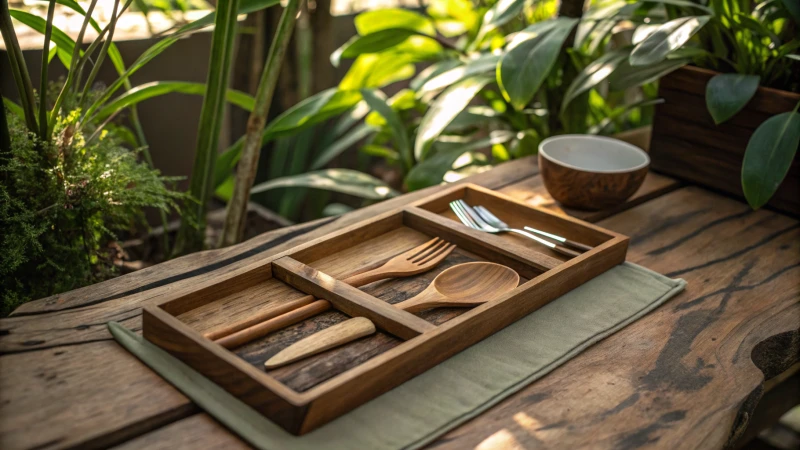
Renewable and Biodegradable Resources
When I first switched to wooden cutlery, it was like a small victory for my conscience. Knowing that these utensils come from responsibly managed forests made me feel like I was part of something bigger—like I was helping preserve our planet's lungs. The best part? These utensils break down naturally, unlike their plastic counterparts that linger in landfills for centuries.
- Renewable Source: The trees used for wooden cutlery4 can be replanted and harvested sustainably. It's comforting to know that I'm not depleting resources but rather supporting a cycle of renewal.
- Biodegradability: Wooden cutlery returns to the earth within months after disposal, leaving no trace behind.
Lower Carbon Footprint
The shift to wooden cutlery also means reducing my carbon footprint. I remember reading how plastic production guzzles energy and thought, "Why not opt for something cleaner?" The manufacturing of wooden utensils is gentler on our planet, requiring less energy and relying less on fossil fuels.
| Material | Energy Use (kWh/kg) | CO2 Emissions (kg CO2/kg) |
|---|---|---|
| Plastic Cutlery | 62 | 2.5 |
| Wooden Cutlery | 10 | 0.8 |
This reduction in energy use not only conserves resources but also aligns with global efforts to combat climate change.
Supporting Sustainable Practices
Embracing wooden cutlery isn't just about personal choices; it's about making a statement. Whether you're at a picnic or hosting an event, showing a commitment to eco-friendly options can speak volumes. I find that people appreciate the effort, and it often sparks conversations about sustainability.
- Consumer Preference: With more consumers gravitating toward eco-friendly products, offering wooden utensils5 can attract those who value sustainability.
- Brand Enhancement: Businesses emphasizing environmental responsibility often gain loyal customers who share these values.
Choosing wooden cutlery is more than just a dining choice—it's a step towards environmental responsibility. By understanding these benefits, you can make informed decisions that support ecological well-being. For further exploration into sustainable materials and their benefits, consider researching sustainable dining solutions6.
Wooden cutlery decomposes faster than plastic.True
Wooden cutlery breaks down in months, unlike plastic, which lasts centuries.
Plastic cutlery has a lower carbon footprint than wooden.False
Wooden cutlery production emits less CO2 and uses less energy than plastic.
How Does the Production Process Impact Sustainability?
Ever wondered how your choices impact the planet? Let's dive into how the production process shapes sustainability and what we can do to make a difference.
The production process impacts sustainability by influencing resource consumption, emissions, and waste generation. Embracing practices like renewable energy use and efficient waste management helps reduce environmental harm, fostering a more sustainable future.
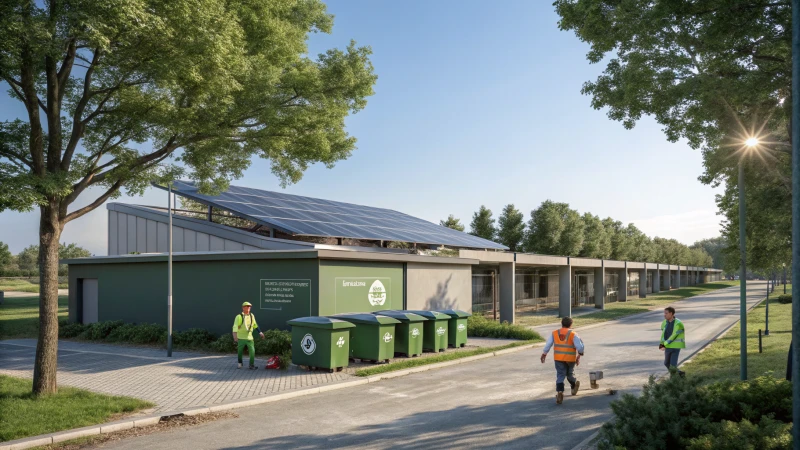
The Role of Resource Consumption
I remember my first attempt at living more sustainably—it was eye-opening. Like many industries, I realized just how heavily my daily habits relied on non-renewable resources. Imagine the difference we can make if companies shifted to renewable energy sources7 like solar and wind! This transition isn’t just about cutting down on emissions; it’s about paving a path to a greener future for everyone.
| Resource Type | Environmental Impact | Sustainable Alternative |
|---|---|---|
| Fossil Fuels | High emissions | Solar, Wind |
| Single-use Plastics | Ocean pollution | Biodegradable materials |
| Water (Inefficient) | Scarcity and pollution | Recycled water systems |
Emissions and Pollution Control
When I think of emissions, I recall a time when driving through thick smog was a part of my daily commute. Thankfully, industries are now embracing pollution control technologies, like carbon capture8, to mitigate such issues. Adopting sustainable manufacturing practices not only helps clear the air but also strengthens a company’s sustainability credentials9, making them leaders in environmental responsibility.
Waste Management Practices
On a personal note, I’ve always been fascinated by the concept of the circular economy10. It’s like a well-orchestrated dance where nothing goes to waste—everything has a purpose. By reusing and recycling materials, companies can significantly decrease landfill contributions, proving that efficient waste management is vital for sustainable production.
Sustainable Production Technologies
Exploring innovative technologies is like stepping into the future. Techniques such as 3D printing and smart manufacturing have caught my attention. They offer precision in resource use, drastically reducing waste and energy consumption. These advancements are crucial for companies looking to optimize operations while minimizing their environmental footprint.
The journey towards sustainable production processes isn’t just about adopting new technologies; it's about cultivating an unwavering commitment to environmental stewardship. As we strive to meet the growing demand for eco-friendly products, integrating these practices into our everyday operations becomes vital. It’s not just good for the planet; it’s also a smart move for businesses aiming to stay competitive in today’s rapidly changing market.
Transitioning to renewable energy reduces carbon footprint.True
Renewable energy sources produce lower emissions, reducing carbon output.
Single-use plastics have no impact on ocean pollution.False
Single-use plastics contribute significantly to ocean pollution globally.
What Should You Consider When Selecting Wooden Cutlery Suppliers?
Choosing a wooden cutlery supplier is like picking a partner for your eco-friendly journey. It's more than just a transaction—it's about values and vision.
When selecting a wooden cutlery supplier, focus on sustainability certifications, quality of materials, customization possibilities, and their production capacity. Ensuring they uphold ethical sourcing and meet your eco-friendly standards is key to aligning with your brand's commitment to sustainability.
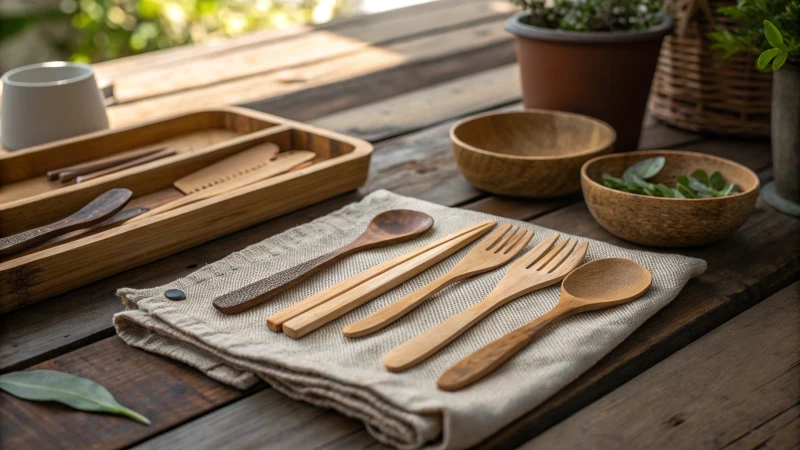
Sustainability Certifications
I remember the first time I realized the importance of sustainability certifications—it was like finding a hidden superpower in the battle against environmental neglect. Choosing suppliers with certifications like FSC (Forest Stewardship Council) ensures that the wood for your cutlery comes from responsibly managed forests. Not only does this reinforce eco-friendly values11, but it also enhances your brand's reputation in the eyes of conscious consumers.
Material Quality
Quality, as they say, is king. I once hosted an event where the cutlery literally fell apart—talk about a nightmare! That's why understanding the durability and type of wood used is crucial. Hardwoods such as birch and bamboo offer not just strength but a smooth finish, making them the perfect candidates for high-quality cutlery.
Customization Options
I’ve always believed that personalization can turn something simple into something special. Imagine having your logo engraved on each piece of cutlery—it's a small touch that speaks volumes about your brand identity. Check if your supplier offers these customization options to add that personal flair to your dining experiences.
| Feature | Importance |
|---|---|
| Sustainability | High |
| Material Quality | High |
| Customization | Medium |
| Production Capacity | High |
Production Capacity
In the fast-paced world we live in, meeting demand without compromising quality is a challenge I know all too well. Make sure your supplier can handle your order size, especially if you're in industries like hospitality industries12 or fast-food chains that require regular large volumes.
Ethical Sourcing Practices
Understanding a supplier’s commitment to ethical sourcing can be a game-changer. Fair labor practices and environmental responsibility are non-negotiables for me. They are not just buzzwords; they represent the heart and soul of sustainable production processes.
Packaging and Distribution
Finally, let's talk packaging—it's like the wrapping on a gift. Eco-friendly packaging supports sustainability goals and speaks to the entire ethos of what you’re trying to achieve. Also, ensure their distribution network is reliable enough to keep your operations smooth and timely.
Ultimately, selecting a wooden cutlery supplier isn't just about meeting business needs; it's about creating partnerships that reflect your brand's ethos and commitment to sustainability. By weighing these factors carefully, you'll find a supplier who not only meets your immediate needs but also supports long-term goals for a greener future.
For more insights into sustainable supply chains13, exploring industry resources can provide deeper understanding of best practices and emerging trends in eco-friendly procurement.
FSC certification ensures wood is from responsibly managed forests.True
FSC certification confirms sustainable forestry practices, ensuring responsible sourcing.
Hardwoods like birch are not suitable for cutlery due to fragility.False
Birch is popular for cutlery due to its strength and smooth finish.
Conclusion
Eco-friendly disposable wooden cutlery reduces plastic waste, supports biodegradability, and utilizes renewable resources, making it a sustainable choice for consumers and businesses alike.
-
Discover how plastic contributes to marine pollution and why switching to biodegradable options like wooden cutlery can help mitigate this issue. ↩
-
Explore tips on incorporating sustainable practices into event planning, including the use of biodegradable materials like wooden cutlery. ↩
-
Learn about potential health risks associated with using plastic cutlery, especially when it comes into contact with hot food items. ↩
-
Explore how sustainable forestry practices ensure renewable resources for making wooden cutlery. ↩
-
Discover why eco-conscious consumers prefer wooden utensils over plastic alternatives. ↩
-
Learn about various sustainable dining solutions and their positive impact on the environment. ↩
-
Learn how shifting to renewable energy sources can cut emissions and enhance sustainability. ↩
-
Understand how carbon capture reduces industrial greenhouse gas emissions. ↩
-
Discover why sustainability credentials matter for businesses in today's eco-conscious market. ↩
-
Explore how the circular economy model reduces waste and enhances resource efficiency. ↩
-
Understanding FSC certifications helps ensure your wood products are sustainably sourced, enhancing your brand's eco-credentials. ↩
-
Sustainable practices in hospitality can attract eco-conscious guests and reduce environmental impact, leading to long-term benefits. ↩
-
Learning about sustainable supply chains can improve your procurement strategies, ensuring ethical and environmentally friendly sourcing. ↩

